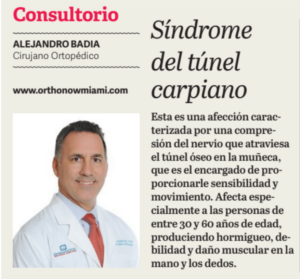
Renowned orthopedic surgeon, Dr. Alejandro Badia, introduces the groundbreaking BioPro® Modular Thumb Implant as a successful alternative for treating painful osteoarthritis of the thumb’s basal joint. Join us as we delve into the quest for innovative therapeutic technologies and the future of thumb pain management.
A small-joint prosthesis that better preserves anatomy and movement of an arthritic thumb is getting – well – “two thumbs up” from many physicians. Miami-based hand and upper- limb orthopedic surgeon, Dr. Alejandro Badia, is using the BioPro® Modular Thumb Implant as a “viable – and successful — treatment alternative,” but says scientists continue the search for ever-newer therapeutic technologies and greater advances in biomaterials to resolve painful osteoarthritis of the thumb’s basal joint.
In fact, authors of a 2017 article in Orthopedic Research and Reviews write that “treatment of thumb basal joint arthritis has yet to be perfected” and that “the goal is to provide pain relief while still preserving range of motion and strength [in the thumb].”
Dr. Badia concurs, but says implant advancements like the BioPro®, which studies show serves as effective replacement for the arthritic basal joint, represent important “steps in the right direction.”
Associated with aging or previous injury, osteoarthritis of the basal – carpometacarpal (CMC) – joint, located at the base of the thumb, is the second most common arthritic condition of the hand, affecting approximately 15 percent of those above 30 years of age and about a third of postmenopausal women. The disorder can result in severe pain and loss of grip function, strength and particularly, the weakness of pinch which can be disabling to activities of daily living.
Scientists theorize that the “basal joint is what most separates us from other simians and that its role in tool- making [makes] us [different] from the remainder of the animal kingdom,” Dr. Badia states in an earlier article published in US Musculoskeletal Review.
Physicians normally pursue conservative treatment approaches for patients in early stages of basal joint arthritis, including use of anti-inflammatory medications, injection of corticosteroids, thumb splinting, and physical therapy. However, “none of these treatments alter the inevitable course of progressive pain — even thumb deformity” — due to osteoarthritis, leaving only surgery as the next line of defense, Dr. Badia says
A multi-center prospective study, led by New York’s Columbia University, was getting underway at the end of 2018 to compare treatment options for arthritic basal joints; identify those that are the most “efficacious, cost- effective, and safe;” and “increase clinician and patient awareness and confidence in…treatment regimens” that are optimal for a patient’s age and activity level.
Osteoarthritis leads to articular cartilage loss. When the disease occurs in the basal joint, that cartilage loss prompts the trapezium, or carpal bone, at the thumb’s base to develop bony overgrowths.
Removal of the trapezium, with ligament reconstruction to stabilize that area of the thumb, and the use of a tendon spacer in place of the diseased joint represent a standard of surgical care for basal joint osteoarthritis. But, this approach, as well as other procedures, including fusion of the basal joint (arthrodesis), has its drawbacks – and complications.
“Removing the trapezium leaves patients few other options if pain continues because there is no longer a presence of that bone,” Dr. Badia says.
Joint fusion, on the other hand, is frequently “associated with decreased range of motion,” transfer of normal forces in the thumb to other hand joints and lack of complete union of bone at the thumb’s base, say authors of a 2017 report in Orthopedic Reviews.
Meanwhile, CMC implants for joint replacement have been available to surgeons for decades as another surgical option, but previous prostheses have sometimes dislocated, fractured or failed or have not led to significant reduction in patient pain or improved thumb function.
Until now!
Dr. Badia reports successful results using BioPro® Modular Thumb Implant. His contention is supported by clinical research. Physicians, writing in Clinical Orthopaedics and Related Research, say BioPro®’s design, including its angle to replicate normal orientation of the thumb and adjustability to fit differences in thumb anatomy, mitigates patient pain, enhances thumb function and results in “good appearance” of the thumb following implantation.
“In general, the main advantage of joint replacement surgery is no bridges have been burned, there is a much faster recovery, minimal pain and good maintenance of the anatomy,” Dr. Badia concludes. “If a patient’s basal joint symptoms persist, the implant can be easily removed, and a more standard surgical procedure performed.”
Related

Badia middle finger MCP cricket player Michael Agard after surgey
Badia middle finger MCP cricket player Michael Agard after surgey…
Read More
July 8, 2024

Consultorio: Síndrome del túnel carpiano
Consultorio: Síndrome del túnel carpiano Febrero 14, 2014 Debe su…
Read More
June 24, 2024

Telemedicina: internet aplicado a la salud
Telemedicina: internet aplicado a la salud Agosto 11, 2017 La…
Read More
June 24, 2024







